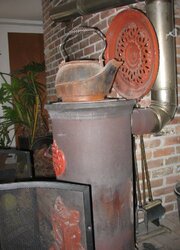I'm still new at this, so I thought my lesson might help other new burners, although experienced burners already know this.
I have a Petit Godin. I burn wood and coal in it. A few weeks ago, I got a scare when I noticed my stovepipe glowing. I shut the air all the way down and let it cool down--for two weeks! I was nervous to try it again.
I did some reading and bought a stovepipe thermometer (Condar Chimguard) I also learned that my regular thermometer (Rutland) was not in the right place. I had it on the front of the stove and it should be on the top.
Previous to this incident, I had monitored the temps with the Rutland on the front of the stove. It took a long time to heat up to the Burn zone, and so I left the air all the way open to get it there. Otherwise, the thermometer read in the Creosote zone, and I didn't want that.
After the glowing stovepipe, and after I got up the courage to try again, I used the Chimguard on the stovepipe and moved the Rutland to the top of the stove. At the beginning of the burn, I monitor the Chimguard because the stovepipe heats up alot faster than the stove itself (this is probably obvious to most of you, but it didn't click with me until the glowing). In order to keep the Chimguard in the Burn zone (and out of the Too Hot zone), I have to shut the air down pretty far. After a little while--30 minutes or so--the Rutland heats up to the Burn zone, and matches the Chimguard.
I think I have this figured out. It makes alot more sense and saves on wood/coal since there's less air and a slower burn. And it's alot safer, obviously.
I have a Petit Godin. I burn wood and coal in it. A few weeks ago, I got a scare when I noticed my stovepipe glowing. I shut the air all the way down and let it cool down--for two weeks! I was nervous to try it again.
I did some reading and bought a stovepipe thermometer (Condar Chimguard) I also learned that my regular thermometer (Rutland) was not in the right place. I had it on the front of the stove and it should be on the top.
Previous to this incident, I had monitored the temps with the Rutland on the front of the stove. It took a long time to heat up to the Burn zone, and so I left the air all the way open to get it there. Otherwise, the thermometer read in the Creosote zone, and I didn't want that.
After the glowing stovepipe, and after I got up the courage to try again, I used the Chimguard on the stovepipe and moved the Rutland to the top of the stove. At the beginning of the burn, I monitor the Chimguard because the stovepipe heats up alot faster than the stove itself (this is probably obvious to most of you, but it didn't click with me until the glowing). In order to keep the Chimguard in the Burn zone (and out of the Too Hot zone), I have to shut the air down pretty far. After a little while--30 minutes or so--the Rutland heats up to the Burn zone, and matches the Chimguard.
I think I have this figured out. It makes alot more sense and saves on wood/coal since there's less air and a slower burn. And it's alot safer, obviously.


 .
.